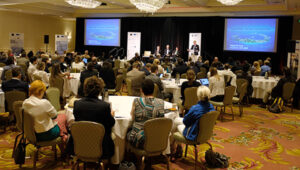Working Together to Address a Changing Ocean

The Ocean Risk Summit, held May 8-10 in Bermuda at the Fairmont Southampton Princess, was a first-of-its-kind event bringing together individuals from the political, economic, environmental, and risk sectors to examine the challenges and risks posed by ocean change and identify innovative approaches to building resilience.
The need to understand the impacts of ocean change, as well as potential threats to human society, was the impetus for the Ocean Risk Summit, which was presented by XL Catlin. A changing ocean has major implications for food security, human health, weather systems, and national security, in addition to impacts on ocean ecosystems and biogeochemical cycles.
On the first day of the event, summit attendees were presented with an overview of the science behind ocean change, including a presentation by BIOS president and CEO William Curry, entitled “Ocean Change: A Bermuda Perspective.”
Other presentations covered a diverse array of topics, including ocean-related weather risks, the role of the insurance industry in managing and reducing ocean risk, potential risks posed to national security and human health, and how a changing ocean affects the economy and market trends.
The day closed with a presentation by José María Figueres, a former president of Costa Rica and founder of Ocean Unite, and John Podesta, distinguished visiting professor from Georgetown University Law Center, on progress since the Global Ocean Commission report was released in 2016. This offered recommendations for governing the global ocean, restoring ocean health, and addressing drivers of ocean decline.
The second day of the event featured interactive working groups designed to get participants to focus their thoughts and expertise on topics ranging from natural capital and ecosystem services to coastal infrastructure and tourism. In the latter part of the day, discussions moved toward the topic of solutions to risks impacting the ocean and included presentations on improving understanding of threats to ocean health, financing mechanisms for addressing ocean risk, and encouraging industry involvement and innovation.
Mark Guishard, program manager for the Risk Prediction Initiative (RPI), located within BIOS, was in attendance. RPI funds academic research relevant to the insurance and reinsurance industry and works to foster dialogue between scientists and reinsurers involved in catastrophic risk.
“It’s gratifying to have an opportunity to remind decision makers in such a high-profile forum that our work on ocean monitoring, climate science and natural hazards is fundamental to society’s understanding of risk,” Guishard said.
Prior to the close of the summit, a new collaboration was announced between The Nature Conservancy and XL Catlin. Designed to address ocean risk by building resilience in coastal areas, the project entails the development of “Blue Carbon Resilience Credits.”
“The hope behind this initiative is that, for the first time, insurance firms and other businesses will be able to offset their carbon footprint while simultaneously better understanding the contribution they are making to reducing coastal hazards in the world’s most vulnerable coastal areas,” The Nature Conservancy wrote in a press release.
A summary of the Ocean Risk Summit, including recaps of keynote talks, panel discussions, and working group activities, is available here: http://enb.iisd.org/oceans/risk/summit-1/html/enbplus186num12e.html
